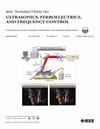Temperature Dependence of the Sensitivity of Hydrophones for Biomedical Ultrasound Exposimetry
IF 3.7
2区 工程技术
Q1 ACOUSTICS
IEEE transactions on ultrasonics, ferroelectrics, and frequency control
Pub Date : 2025-01-09
DOI:10.1109/TUFFC.2025.3527625
引用次数: 0
Abstract
Though it has been recognized that the sensitivity of hydrophones depends on the temperature of the water they are used in, the amount of specific data that is available is very limited. This is possible because the measurements are technically challenging, laborious, and time-consuming. A broadband primary hydrophone calibration setup was extended to implement stable calibration conditions at different temperature settings. Four hydrophones of different types commonly used in ultrasound exposimetry were then characterized in the range from 17 °C to 29 °C, and average change rates of the sensitivity with temperature were determined for different ultrasonic frequencies. Two different membrane hydrophones showed an increase in sensitivity with increasing temperature in the range from 0.55% to 1.10% per 1 °C temperature rise within their bandwidths. The results for a capsule-type and a needle-type hydrophone were different in the sense that a decreasing sensitivity with increasing temperature was also observed. For the capsule-type hydrophone, a small increase was observed up to 15 MHz and a decrease for higher frequencies. The needle-type hydrophone provided a decrease at all frequencies, and the results were more noisy. Data, as determined in this study, can be applied to correct acoustic output measurements of medical ultrasonic equipment if the water temperature of the hydrophone application differs from that during calibration. Alternatively, it may suffice in some applications to consider a sensitivity change with temperature within the uncertainty estimation of the exposure measurement, in particular, if the temperature difference is limited to 1 °C or 2 °C.生物医学超声暴露水听器灵敏度的温度依赖性。
虽然人们已经认识到水听器的灵敏度取决于使用它们的水的温度,但可获得的具体数据数量非常有限。这可能是因为测量在技术上具有挑战性,费力且耗时。扩展了宽带主水听器校准装置,以实现在不同温度设置下的稳定校准条件。在17℃~ 29℃范围内对常用的4种不同类型的超声暴露水听器进行了表征,测定了不同超声频率下灵敏度随温度的平均变化率。两种不同的膜水听器的灵敏度随温度的升高而增加,在其带宽范围内,温度每升高1°C,灵敏度增加0.55%至1.10%。胶囊型水听器和针型水听器的灵敏度随温度的升高而降低。对于胶囊型水听器,在15 MHz以下观察到微小的增加,而在更高频率下观察到减少。针型水听器在所有频率下都有降低,结果噪声更大。如果水听器应用的水温与校准时的水温不同,则本研究确定的数据可用于校正医用超声设备的声输出测量。另外,在某些应用中,在曝光测量的不确定度估计范围内考虑灵敏度随温度的变化就足够了,特别是当温差限制在1或2度时。
本文章由计算机程序翻译,如有差异,请以英文原文为准。
求助全文
约1分钟内获得全文
求助全文
来源期刊
CiteScore
7.70
自引率
16.70%
发文量
583
审稿时长
4.5 months
期刊介绍:
IEEE Transactions on Ultrasonics, Ferroelectrics and Frequency Control includes the theory, technology, materials, and applications relating to: (1) the generation, transmission, and detection of ultrasonic waves and related phenomena; (2) medical ultrasound, including hyperthermia, bioeffects, tissue characterization and imaging; (3) ferroelectric, piezoelectric, and piezomagnetic materials, including crystals, polycrystalline solids, films, polymers, and composites; (4) frequency control, timing and time distribution, including crystal oscillators and other means of classical frequency control, and atomic, molecular and laser frequency control standards. Areas of interest range from fundamental studies to the design and/or applications of devices and systems.

 求助内容:
求助内容: 应助结果提醒方式:
应助结果提醒方式:


